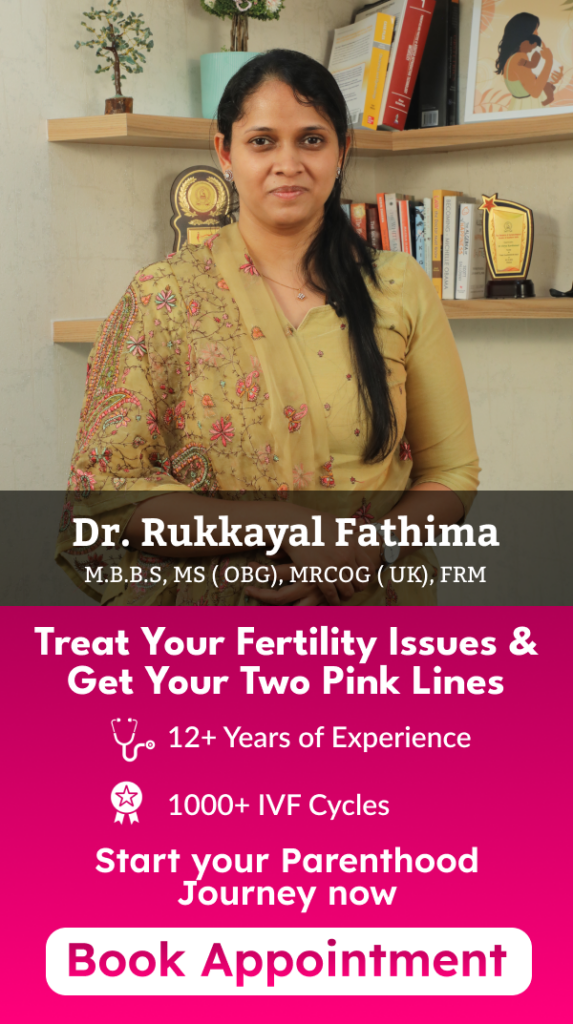Most fertility clinics opt for IVF treatments only when other fertility treatments like medication, surgery, and IUI have not been able to make a woman pregnant. In such cases, the first question couples would ask regarding IVF will be its success rate.
Most couples undergo IVF treatments with high hopes, but those hopes are crushed for one reason or another because the IVF success rate on the first try is not very high. Couples must try two to three times to finally be able to conceive.
Are you suffering from infertility and planning to undergo IVF treatments? Read this article and learn more about the success rate you can expect from IVF before starting the treatments.
IVF Success Rate Statistics
The success rates of IVF treatments in India can be compared to other developed countries like the USA., with a high success rate of 50 to 60 percent. If the woman is younger than 35, the success rate can even go up to 65%.
Age is the primary factor that affects the success rate of IVF treatments. Here is the average success rate for women depending on their age.
Age | Live birth per egg retrieval |
Younger than 35 | 54.5% |
35-37 | 41% |
38-40 | 26.5% |
41-42 | 13% |
Older than 42 | 4.2% |
Key Factors Affecting IVF Success Rates
Maternal age and infertility
The woman’s age might cause infertility problems which could be the reason for IVF failure. As she grows older, a woman’s chances of getting pregnant also decrease. However, the woman’s body condition and medical history can also contribute to IVF success.
Embryo quality and selection
A couple’s reproductive age can drastically affect the quality of their eggs and sperm, thus indirectly affecting the quality of the embryo as well. Some couples also choose IVF because they don’t want to pass on their genetic diseases to their offspring.
Fertility doctors do several tests on the embryo, identify abnormal chromosomes or any genetic disabilities, and choose the best embryo that can lead to a successful pregnancy and a healthy baby.
Sperm quality and male factor infertility
Even though many people believe that infertility and childbirth are related to female issues, men can also be the cause of infertility. Issues like low sperm volume, motility, etc., can affect the quality of the sperm and decrease its chances of fertilizing the eggs.
In the case of male factor infertility, couples can choose to undergo ICSI treatment (intracytoplasmic Sperm Injection), where a single, healthy sperm is selected and injected into the cytoplasm using a needle for fertilization.
Uterine health and implantation potential
A healthy and stable uterus is needed to implant and develop a baby till full term. Some health factors like insufficient endometrial thickness, endometriosis, and other immunological factors can restrict the uterus from implanting and sustaining the embryo for a long period.
Lifestyle factors and pre-existing medical conditions
The parent’s lifestyle is the primary external factor determining whether an embryo can thrive and be healthy. By Quitting alcohol consumption and smoking you can keep your eggs healthy. so, one should give up smoking and alcohol at least three months before the IVF process.
Maintaining a healthy weight should also be taken into consideration. Obesity has been demonstrated to impact the body’s ability to metabolize hormones and reproductive medications. To prevent these factors from decreasing IVF success rates, it is crucial that a patient be able to govern her lifestyle.
Advanced Techniques to Improve IVF Success Rates
Preimplantation genetic testing (PGT)
Preimplantation genetic testing (PGT) is a screening test done to genetically examine embryos fertilized through IVF before being transferred into the uterus.
Genetically abnormal embryo is one of the most common causes of unsuccessful IVF treatments. PGT can guarantee that the embryo chosen for transfer has the right number of chromosomes, lowering the risk of an unsuccessful IVF cycle and miscarriage.
Assisted hatching
Patients receiving IVF treatment can undergo an extra procedure called assisted hatching. IVF-produced embryos have a stiff outer coat of cells called the zona pellucida surrounding them. You can consider this outer layer as the ‘shell’ of the embryo.
This “shell” is what prevents an embryo from implanting into the uterus and resulting in pregnancy. Fertility doctors can help the embryo “hatch” from its “shell” during assisted hatching by making a tiny fissure in the zona pellucida. Some people may have higher pregnancy rates due to assisted hatching because it can help the embryo implant in the uterus.
Intracytoplasmic sperm injection (ICSI)
ICSI treatment is another way of conducting IVF treatments. This procedure is recommended when the couple has male-factor infertility issues like low sperm count and motility. In this process, a micropipette, which is a tiny needle, holds a single, healthy sperm that is inserted into the egg’s cytoplasm.
Frozen embryo transfer (FET)
The retrieval and fertilization process is the same for both fresh and frozen embryo transfers. In fresh embryo transfer, the embryos are transferred back into the uterus within 5 to 6 days of egg retrieval.
In frozen embryo transfer, the embryos are frozen and stored at lower temperatures for later use. This process is called cryopreservation. This process does not affect the quality of the egg. In fact, most fertility clinics prefer this method because they have a 15-20% higher chance of pregnancy than fresh embryo transfer.
Time-lapse embryo imaging
Time-lapse embryo imaging and incubation are used in IVF to assist embryologists in choosing the embryos most likely to result in pregnancy. In traditional IVF, the embryologist will periodically remove the developing embryos from the incubator to examine them under a microscope.
In time-lapse embryo imaging, the embryologist can take several pictures of the embryos as they develop without disturbing them. This avoids removing the embryos from the incubator and enables the embryologist to see each embryo simultaneously throughout its development rather than just once each day.
The embryologist can then decide which embryo to implant depending on its development rate and the quantity and quality of its cells.
Conclusion
Infertility is very personal and can be influenced by several factors like relationship dynamics, family support, religious convictions, financial situation, way of life, and mental health. Results should not be predicted since it is different for each person.
You can confidently approach the road to motherhood by being aware of IVF success rates based on the number of embryos, putting strategies in place to increase your chances, and working with a respected fertility clinic. To increase your chances of IVF success in the first attempt, be positive, and patient, and surround yourself with a solid support system.
Frequently asked questions
Infertility has become a common problem that affects several men and women worldwide. Though it is widespread, most people don’t know when they should take action and consult a fertility specialist.
Here’s when they should go to a doctor for treatments.
- They have difficulty conceiving a child.
- They are above 40 years of age.
- They have an existing medical condition.
- The woman has irregular or painful periods.
No, IVF does not have a success rate of 100%. Age, the underlying reason for infertility, and the quantity and quality of eggs and sperm used in the procedure are some of the variables that affect IVF success rates.
There is no safe or right age for IVF. Most fertility clinics advise women to get IVF before the age of 40, though, as success rates sharply decline as women become older.
A successful pregnancy may require one or more IVF cycles, depending on the specifics of the case. However, most couples would typically need two to three IVF sessions to become pregnant.





